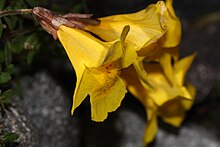Erythranthe tilingii
| Erythranthe tilingii | |
|---|---|

| |
| Scientific classification | |
| Kingdom: | Plantae |
| Clade: | Tracheophytes |
| Clade: | Angiosperms |
| Clade: | Eudicots |
| Clade: | Asterids |
| Order: | Lamiales |
| Family: | Phrymaceae |
| Genus: | Erythranthe |
| Species: | E. tilingii
|
| Binomial name | |
| Erythranthe tilingii (Regel) G.L.Nesom
| |
Erythranthe tilingii is a species of monkeyflower known by the common name Tiling's monkeyflower. It was formerly known as Mimulus tilingii.[1][2][3][4]
Distribution
[edit]It is native to much of western North America, from Alaska to California to New Mexico to Montana. It grows in moist and wet habitats, such as streambanks and mountain meadows, and is generally found at high elevation.

Description
[edit]Erythranthe tilingii is a rhizomatous perennial herb growing 2 to 35 centimeters tall. The oppositely arranged oval leaves may be several centimeters long and some are borne on short petioles. The yellow flower may be over 4 centimeters long, its narrow tubular throat opening into a wide, two-lipped mouth. The base of the flower tube is encapsulated in a calyx of sepals with uneven lobes.
Erythranthe tilingii is often nearly impossible to distinguish from its common relative, Mimulus guttatus, as their characteristics can intergrade; one of the most notable differences is the arrangement of the flowers, which are axial in M. tilingii but in a raceme in M. guttatus.[5][6][7] By 2014 three species that were formerly part of E. tilingii had been made their own separate species: Erythranthe caespitosa, Erythranthe corallina, Erythranthe minor.[8][9]
References
[edit]- ^ Barker, W.R.; Nesom, G.L.; Beardsley, P.M.; Fraga, N.S. (2012), "A taxonomic conspectus of Phrymaceae: A narrowed circumscriptions for Mimulus, new and resurrected genera, and new names and combinations" (PDF), Phytoneuron, 2012–39: 1–60
- ^ Beardsley, P. M.; Yen, Alan; Olmstead, R. G. (2003). "AFLP Phylogeny of Mimulus Section Erythranthe and the Evolution of Hummingbird Pollination". Evolution. 57 (6): 1397–1410. doi:10.1554/02-086. JSTOR 3448862. PMID 12894947.
- ^ Beardsley, P. M.; Olmstead, R. G. (2002). "Redefining Phrymaceae: the placement of Mimulus, tribe Mimuleae, and Phryma". American Journal of Botany. 89 (7): 1093–1102. doi:10.3732/ajb.89.7.1093. JSTOR 4122195. PMID 21665709.
- ^ Beardsley, P. M.; Schoenig, Steve E.; Whittall, Justen B.; Olmstead, Richard G. (2004). "Patterns of Evolution in Western North American Mimulus (Phrymaceae)". American Journal of Botany. 91 (3): 474–4890. doi:10.3732/ajb.91.3.474. JSTOR 4123743. PMID 21653403.
- ^ Jepson Manual treatment for Mimulus tilingii
- ^ Southwest Colorado Wildflowers
- ^ Jepson Manual dichotomous key for Mimulus
- ^ Nesom, G. L. (2012). "Taxonomy of Erythranthe sect. Simiola (Phrymaceae) in the USA and Mexico" (PDF). Phytoneuron. 40: 1–23. ISSN 2153-733X.
- ^ Nesom, Guy L. (2014). "Using Name in the Genus Mimulus" (PDF). guynesom.net. Retrieved 20 February 2017.
External links
[edit]- USDA Plants Profile: Mimulus tilingii
- Jepson Manual Treatment - Mimulus tilingii
- Mimulus tilingii - Photo gallery
